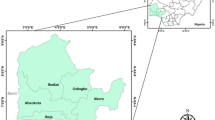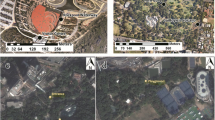Abstract
Human thermal comfort is influenced by different climatic parameters. The effect of rain and snow events on human thermal comfort has been less explored in the available literature. The work presented here investigates outdoor and indoor thermal comfort using the physiological equivalent temperature (pet) and wind chill temperature (WCT) indices and Givoni bioclimatic chart for rainy and snowy days as well as a day prior to and a day post snow and rain events in Ardabil. Results indicated that snow and rain events have cooling effects on both indoor and outdoor thermal sensation. The cooling effect of rainy and snowy days is higher than a day prior to and a day post events. Also, the cooling effect of the snow and rain increases by the intensity of the events (> 10 mm/day). Based on the PET and WCT outputs, the cooling effect of the snow events with intensity higher than 10 mm a day is about 1.77 and 0.80 °C less than events under 10-mm a day intensity. The same pattern was observed for rain events. Analysis of the cooling effect of event duration on outdoor thermal comfort indicated that the events with more than 2-day duration have more cooling effect on thermal sensation. Finally, due to different cooling effects of snow and rain events on indoor thermal sensation, different types of bioclimatic strategies should be used inside the buildings during snowy and rainy days in Ardabil.






Similar content being viewed by others
References
Adekunle TO, Nikolopoulou M (2019) Winter performance, occupants’ comfort and cold stress in prefabricated timber buildings. Build Environ 149:220–240
Amindeldar S, Heidari S, Khalili M (2017) The effect of personal and microclimatic variables on outdoor thermal comfort: a field study in Tehran in cold season. Sustain Cities Soc 32:153–159
Araźny A, Wyszyński P, Przybylak R (2019) A comparison of bioclimatic conditions on Franz Josef Land (the Arctic) between the turn of the nineteenth to twentieth century and present day. Theor Appl Climatol 137(3):1–16
Charalampopoulos I, Tsiros I (2017) A preliminary study on the effect of rainfall events on human thermal comfort under hot weather conditions. Perspectives on Atmospheric Sciences, Springer: 329-334
Chen L, Wen Y, Zhang L, Xiang WN (2015) Studies of thermal comfort and space use in an urban park square in cool and cold seasons in Shanghai. Build Environ 94:644–653
Chen X, Xue P, Liu L, Gao L, Liu J (2018) Outdoor thermal comfort and adaptation in severe cold area: a longitudinal survey in Harbin, China. Build Environ 143:548–560
Chun CY, Tamura A (1998) Thermal environment and human responses in underground shopping malls vs department stores in Japan. Build Environ 33(2-3):151–158
Chun C, Kwok A, Mitamura T, Miwa N, Tamura A (2008) Thermal diary: connecting temperature history to indoor comfort. Build Environ 43(5):877–885
Da Silveira Hirashima SQ, Katzschner A, Ferreira DG, de Assis ES, Katzschner L (2018) Thermal comfort comparison and evaluation in different climates. Urban Clim 23:219–230
Daneshvar MRM, Bagherzadeh A, Tavousi T (2013) Assessment of bioclimatic comfort conditions based on physiologically equivalent temperature (PET) using the RayMan model in Iran. Central Eur J Geosci 5(1):53–60
Dekay M , Brown G (2013) Sun, wind, and light: architectural design strategies. Wiley
Deng Y, Cao B, Yang H, Liu B (2019) Effects of local body heating on thermal comfort for audiences in open-air venues in 2022 Winter Olympics. Build Environ 165:106363
Djongyang N, Tchinda R, Njomo D (2010) Thermal comfort: a review paper. Renew Sust Energ Rev 14(9):2626–2640
Donaldson GC, Rintamäki H, Näyhä S (2001) Outdoor clothing: its relationship to geography, climate, behaviour and cold-related mortality in Europe. Int J Biometeorol 45(1):45–51
Du J, Sun C, Xiao Q, Chen X, Liu J (2020) Field assessment of winter outdoor 3-D radiant environment and its impact on thermal comfort in a severely cold region. Sci Total Environ 709:136175
Fabbri K (2015) A brief history of thermal comfort: from effective temperature to adaptive thermal comfort. Indoor Thermal Comfort Perception. Springer, Cham, 7-23
Fanger PO (1970) Thermal comfort. Analysis and applications in environmental engineering. Thermal comfort. Analysis and applications in environmental engineering
Farajzadeh H, Matzarakis A (2009) Quantification of climate for tourism in the northwest of Iran. Meteorol Appl 16(4):545–555
Farajzadeh H, Matzarakis A (2012) Evaluation of thermal comfort conditions in Ourmieh Lake, Iran. Theor Appl Climatol 107(3-4):451–459
Gagge AP (1936) The linearity criterion as applied to partitional calorimetry. Am J Physiol Leg Content 116(3):656–668
Gaitani N, Mihalakakou G, Santamouris M (2007) On the use of bioclimatic architecture principles in order to improve thermal comfort conditions in outdoor spaces. Build Environ 42(1):317–324
Givoni B (1976) Man, climate and architecture, 2dedition, UK
Hanafi A, Atashgahi H (2017) Determination of thermal bioclimatic conditions for touristsin west and North West of Iran using PET. Int J Environ Agric Biotechnol 2(1)
He X, An L, Hong B, Huang B, Cui X (2020) Cross-cultural differences in thermal comfort in campus open spaces: a longitudinal field survey in China’s cold region. Build Environ 172:106739
Honjo T (2009) Thermal comfort in outdoor environment. Glob Environ Res 13(2009):43–47
Houghten FC (1923) Determining lines of equal comfort. ASHVE Trans 29:163–176
Jendritzky G (1990) Methodik zur Räumlichen Bewertung der Thermischen Komponente im Bioklima des Menschen: Fortgeschriebenes Klima-Michel-Modell. na
Jin H, Qiao L, Wang B (2017) Field research and study of campus thermal environment in winter in severe cold areas. Energy Procedia 134:607–615
Jin H, Liu S, Kang J (2020) Gender differences in thermal comfort on pedestrian streets in cold and transitional seasons in severe cold regions in China. Build Environ 168:106488
Kubilay A, Derome D, Carmeliet J (2019) Impact of evaporative cooling due to wetting of urban materials on local thermal comfort in a street canyon. Sustain Cities Soc 49:101574
Kumar V, Hewage K, Haider H, Sadiq R (2016) Techno-economic performance evaluation of building cooling systems: a study of snow storage and conventional chiller systems. Cold Reg Sci Technol 130:8–20
Li R, Chi X (2014) Thermal comfort and tourism climate changes in the Qinghai–Tibet Plateau in the last 50 years. Theor Appl Climatol 117(3-4):613–624
Liu W, Lian Z, Liu Y (2008) Heart rate variability at different thermal comfort levels. Eur J Appl Physiol 103(3):361–366
Liu W, Zhang Y, Deng Q (2016) The effects of urban microclimate on outdoor thermal sensation and neutral temperature in hot-summer and cold-winter climate. Energy Build 128:190–197
Martinez-Molina A, Boarin P, Tort-Ausina I, Vivancos JL (2017) Post-occupancy evaluation of a historic primary school in Spain: comparing PMV, TSV and PD for teachers’ and pupils’ thermal comfort. Build Environ 117:248–259
Matzarakis A, Mayer H (1997) Heat stress in Greece. Int J Biometeorol 41(1):34–39
Matzarakis A, Rutz F, Mayer H (2007) Modelling radiation fluxes in simple and complex environments—application of the RayMan model. Int J Biometeorol 51(4):323–334
Matzarakis A, Rutz F, Mayer H (2010) Modelling radiation fluxes in simple and complex environments: basics of the RayMan model. Int J Biometeorol 54(2):131–139
Mendes A, Bonassi S, Aguiar L, Pereira C, Neves P, Silva S, Mendes D, Guimarães L, Moroni R, Teixeira JP (2015) Indoor air quality and thermal comfort in elderly care centers. Urban Clim 14:486–501
Morakinyo TE, Ogungbenro SB, Abolude AT, Akinsanola AA (2019) Quantifying the effect of rain events on outdoor thermal comfort in a high-density city, Hong Kong. Int J Biometeorol 63(1):19–27
Mujan I, Anđelković AS, Munćan V, Kljajić M, Ružić D (2019) Influence of indoor environmental quality on human health and productivity-a review. J Clean Prod 217:646–657
Passel CF (1945) Measurements of dry atmospheric cooling in subfreezing temperatures. Proceedings of the American Philosophical Society Held at Philadelphia for Promoting Useful Knowledge, The Society
Potter J, de Dear R (2000) Field study to calibrate outdoor thermal comfort index. Biometeorology and urban climatology at the turn of the millennium: 315-320
Roshan Gh, Moghbel M (2020) Quantifying the cooling effect of rain events on outdoor thermal comfort in the southern coastal stations of the Caspian Sea. J Therm Biol. 102733. https://doi.org/10.1016/j.jtherbio.2020.102733
Roshan GR, Ghanghermeh A, Attia S (2017a) Determining new threshold temperatures for cooling and heating degree day index of different climatic zones of Iran. Renew Energy 101:156–167
Roshan GR, Farrokhzad M, Attia S (2017b) Defining thermal comfort boundaries for heating and cooling demand estimation in Iran's urban settlements. Build Environ 121:168–189
Roshan GR, Oji R, Attia S (2019) Projecting the impact of climate change on design recommendations for residential buildings in Iran. Build Environ 155:283–297
Roshan Gh, Moghbel M, Attia Sh (2020) Evaluating the wind cooling potential on outdoor thermal comfort in selected Iranian climate types. J Therm Biol 92(102660):1–13.
Shui T, Liu J, Zhang P, Liu S, Zhao Z (2016) Development of an urban canopy model for the evaluation of urban thermal climate with snow cover in severe cold regions. Build Environ 95:160–170
Siple PA, Passel CF (1945) Measurements of dry atmospheric cooling insubfreezing temperatures. Proc Am Philos Soc 89:177–199
Thach TQ, Zheng Q, Lai PC, Wong PP, Chau PY, Jahn HJ, Plass D, Katzschner L, Kraemer A, Wong CM (2015) Assessing spatial associations between thermal stress and mortality in Hong Kong: a small-area ecological study. Sci Total Environ 502:666–672
Xi T, Wang Q, Qin H, Jin H (2020) Influence of outdoor thermal environment on clothing and activity of tourists and local people in a severely cold climate city. Build Environ 173:106757
Xu M, Hong B, Mi J, Yan S (2018) Outdoor thermal comfort in an urban park during winter in cold regions of China. Sustain Cities Soc 43:208–220
Yao J, Yang F, Zhuang Z, Shao Y, Yuan PF (2018) The effect of personal and microclimatic variables on outdoor thermal comfort: A field study in a cold season in Lujiazui CBD, Shanghai. Sustain Cities Soc 39:181–188
Acknowledgments
We thank Golestan University for their support in the project. We also would like to thank the reviewers for their help and suggestions on data analyses and interpretations. The authors thank the Iran Meteorological Organization for providing the analyzed meteorological data.
Funding
This work was partially supported by the Golestan University under grant no. 991992.
Author information
Authors and Affiliations
Corresponding author
Additional information
Publisher’s note
Springer Nature remains neutral with regard to jurisdictional claims in published maps and institutional affiliations.
Rights and permissions
About this article
Cite this article
Roshan, G., Moghbel, M. Rain and snow event cooling effect: a comparison on outdoor and indoor thermal comfort in Ardabil, northwest of Iran. Theor Appl Climatol 142, 1581–1594 (2020). https://doi.org/10.1007/s00704-020-03403-0
Received:
Accepted:
Published:
Issue Date:
DOI: https://doi.org/10.1007/s00704-020-03403-0




